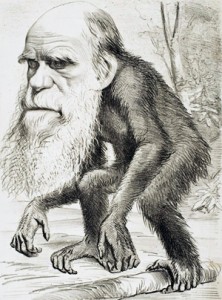Based upon mathematics, if you believe in “evolution,” you posses a much greater faith than I do as a Christian. In 
What are the odds that you can flip heads on a penny 12 million times in a row without tails coming up?
The answer is .5 to the 12 millionth power. Which could also be stated as 10 to the 3 million 600’Th power (1 with 3,600,000 zeroes after it). These are the same odds that E Coli developed 12,000,000 right-handed nucleotides by chance without one left handed nucleotide being added. The building blocks of DNA and proteins are molecules, which can exist, in both right and left-handed forms. This is called “chirality.” The best result that experiments have shown has been a 3/7 chance. Meaning; from one nucleotide to the next there is a 3/7 chance that it will be the same hand as the previous nucleotide.
The Odds
(The following are taken from books and/or found at other web-sites)
During the last several decades a number of prestigious scientists have attempted to calculate the mathematical probability of the random-chance origin of life. The results of their calculations reveal the enormity of the dilemma faced by materialists. In the 1950’s, Harold Blum estimated the probability of just a single protein arising spontaneously from a “primordial soup.” Equilibrium and the reversibility of biochemical reactions eventually led Blum to state:
“The spontaneous formation of a polypeptide of the size of the smallest known proteins seems beyond all probability. This calculation alone presents serious objection to the idea that all living matter and systems are descended from a single protein molecule which was formed as a ‘chance’ act.” In the 1970’s British astronomer Sir Frederick Hoyle set out to calculate the mathematical probability of the spontaneous origin of life from a primordial soup environment. Applying the laws of chemistry, mathematical probability and thermodynamics, he calculated the odds of the spontaneous generation of the simplest known free-living life form on earth – a bacterium.
Hoyle and his associates knew that the smallest conceivable free-living life form needed at least 2,000 independent functional proteins in order to accomplish cellular metabolism and reproduction. Starting with the hypothetical primordial soup, he calculated the probability of the spontaneous generation of just the proteins of a single amoeba. He determined that the probability of such an event is one chance in ten to the 40 thousandth power.
Prior to this project, Hoyle was a believer in the spontaneous generation of life. This project, however, changed his opinion 180 degrees. Mathematicians tell us that if an event has a probability, which is less likely than one chance in 10 to the 50’Th power, then that event is mathematically impossible. Such an event, if it were to occur, would be considered a miracle.

In his calculations, Hoyle assumed that the primordial soup consisted only of left-handed amino acids. Hoyle knew that if the soup consisted of equal portions of right and left-handed amino acids, then the mathematical probability of the origin of pure left-handed proteins would be exactly zero.
After completing his research, Hoyle stated that the probability of the spontaneous generation of a single bacterium “is about the same as the probability that a tornado sweeping through a junk yard could assemble a 747 from the contents therein. Hoyle also stated:
“The likelihood of the formation of life from inanimate matter is one to a number with 40 thousand naughts [zeros] after it. It is enough to bury Darwin and the whole theory of evolution. There was no primeval soup, neither on this planet nor on any other, and if the beginnings of life were not random they must therefore have been the product of purposeful intelligence.” Hoyle’s calculations may seem impressive, but they don’t even begin to approximate the difficulty of the task. He only calculated the probability of the spontaneous generation of the proteins in the cell. He did not calculate the chance formation of the DNA, RNA, nor the cell wall that holds the contents of the cell together.
Harold Morowitz, a Yale University physicist, has made a more realistic estimate for spontaneous generation. Morowitz imagined a broth of living bacteria that were super-heated so that all the complex chemicals were broken down into their basic building blocks. After cooling the mixture, he concluded that the odds of a single bacterium re-assembling by chance are one in 10 to the 100 billionth power. This number is so large that it would require several thousand blank books just to write it out. To put this number into perspective, it is more likely that you and your entire extended family would win the state lottery every week for a million years than for a bacterium to form by chance.
In his book, Origins-A Skeptics Guide to the Creation of Life on Earth, Robert Shapiro gives a very realistic illustration of how one might estimate the odds of the spontaneous generation of life. Shapiro begins by allowing one billion years (5 x 10 to the 14’Th power minutes) for spontaneous biogenesis. Next he notes that a simple bacterium can make a copy of itself in twenty minutes, but he assumes that the first life was much simpler. So he allows each trial assembly to last one minute, thus providing 5 x 10 to the 14’Th power trial assemblies in 1 billion years to make a living bacterium.
Next he allows the entire ocean to be used as the reaction chamber. If the entire ocean volume on planet earth were divided into reaction flasks the size of a bacterium we would have 10/36 separate reaction flasks. He allows each reaction flask to be filled with all the necessary building blocks of life. Finally, each reaction chamber is allowed to proceed through one-minute trial assemblies for one billion years. The result is that there would be 10 to the 51’St power tries available in 1 billion years. According to Morowitz we need 10 to the 100 billionth power trial assemblies. Regarding the probabilities calculated by Morowitz, Robert Shapiro wrote:
“The improbability involved in generating even one bacterium is so large that it reduces all considerations of time and space to nothingness. Given such odds, the time until the black holes evaporate and the space to the ends of the universe would make no difference at all. If we were to wait, we would truly be waiting for a miracle.”
Regarding the origin of life Francis Crick, winner of the Nobel Prize in biology, stated in 1982:
“An honest man, armed with all the knowledge available to us now, could only state that in some, the origin of life appears at the moment to be almost a miracle, so many are the conditions which would have had to have been satisfied to get it going.”
Regarding the probability of spontaneous generation, Harvard University biochemist and Nobel Laureate, George Wald stated in 1954:
“One has to only contemplate the magnitude of this task to concede that the spontaneous generation of a living organism is impossible. Yet we are here-as a result, I believe, of spontaneous generation.”
In this incredible statement by Wald we see that his adherence to the materialist’s paradigm is independent of the evidence. Wald’s belief in the “impossible” can only be explained by faith: “…the substance of things hoped for, the evidence of things not seen.”
Despite these incredible odds, and the seemingly insurmountable problems, spontaneous generation is taught as a fact from grammar school to university. In fact, NASA scientists reported to the press in 1991 their opinion that life arose spontaneously not once, but multiple times, because previous attempts were wiped out by cosmic catastrophes. George Wald eloquently points out the reason for this fanatical adherence to spontaneous generation:
“When it comes to the origin of life there are only two possibilities: Creation or spontaneous generation. There is not third way.
Spontaneous generation was disproved one hundred years ago, but that leads us to only one other conclusion, that of supernatural creation. We cannot accept that on philosophical grounds; therefore, we choose to believe the impossible: That life arose spontaneously by chance!”
According to Wald, it’s not a matter of the evidence; it’s a matter of philosophy! Like George Wald, many people do not like, and cannot accept the alternative: that a transcendent Creator created all life on earth. So, as Wald said, they are willing to “believe the impossible,” in order to cling to their belief that the universe is a closed system. A system that has no room for such a Creator.
There are so many examples, mathematically, why evolution is all but impossible, that in-order to share them all would require hundreds, in not thousands, of pages. And by now, I’m sure most readers didn’t make it this far…
In conclusion let me add…
The principles for practicing science itself are not taught in school. As an alternative, we concentrate on what subjects may or may not be taught. Maybe we need to ascertain how to teach science, rather than telling science what it may or may not construe about the universe.









